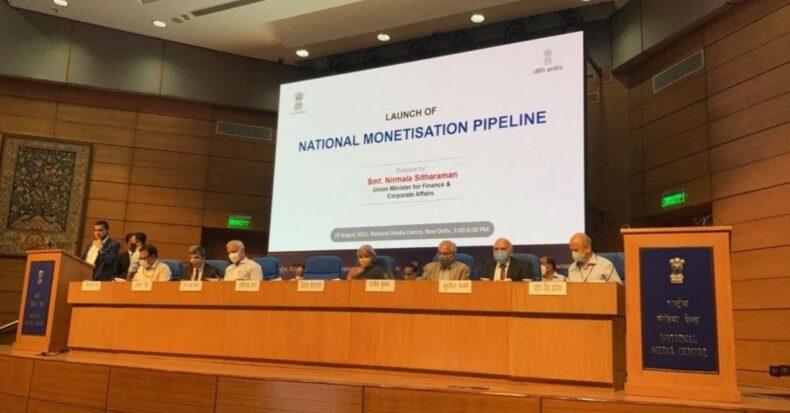Under the name of Asset Monetization, the Indian government is listing out the government’s infrastructure assets of Rs 6 lakh crore to be sold over the next four years.
The Union Finance Minister Nirmala Sitharaman launched the National Monetisation Pipeline (NMP) on Monday, August 23, 2021.
The budget 2021-22 proposed NMP for monetizing DFC assets by railways, oil and gas pipelines of IOC, GAIL and HP, operational toll roads of NHAI, warehousing assets of CPSEs and AAI’s airports in tier 3 and tier 3 cities.
The planned sales are in line with the PM’s strategic divestment policy, under which the State will retain a presence in only a few identified sectors, with the rest privatized.
On Monday, the Union Finance Minister stated that” We are going to monetize brownfield assets that are either languishing or underutilized or not fully monetized”.
The Finance Minister further added,” It is high time for India to recognize that the time to make the best out of the assets has come. With changing times, the key focus for public expenditure is shifting to budget identified infrastructure”.
What is the Purpose of Asset Monetization?
Since the government funding is limited and banks have already burnt their hands in lending infrastructure, the private sector is inevitable in meeting the financial gap.
According to a report from Asian Development Bank, Asia alone needs an infrastructure investment estimated at $ 26 trillion per year.
Asset monetization offers a respite where an underdog asset becomes a revenue earner for the State.
The monetization process follows a mechanism where revenue proceeds are reinvested in newly needed infrastructure without resorting to public debt.
The programme’s strategic objective is to unlock the value of languishing investments in the public sector by tapping long-term patient capital to leverage further public investments.
One can put money into several uses rather than locking it in the bank accounts. It also leads to a comprehensive modernization drive with innovative techniques and ideas while replacing obsolete ones.
How will Asset Monetization Impact the Well-Being of the Country?
Infrastructural monetization can yield appropriate returns for the concerned PSU and promote regional development.
These assets have been lying idle for a long time. With private entities bidding for them, they can create productive assets like factories leading to regional economic development.
These additional resources can be utilized for restructuring, reinvestment and expansion by the concerned PSU-trimming down the market borrowings by PSUs and bringing the interest payment burden down.
Asset monetization will unlock resources leading to value-unblocking. However, the highlight is that NMP will not monetize land. The government will only monetize brownfield assets.
Economics and Government’s Plan Behind the Monetization
Monetization of unutilized assets which are non-operational is on the way. The railway is the front-runner owing approximately 47,000 hectares of land.
According to the institutional framework for asset monetization, a mechanism will be put in place to dispose of or lease identified public assets.
Based on the value of the acquisition, a threshold limit will be set. Any asset identified below the threshold value will be long-term leased or disposed of by the concerned ministry, CPSE etc.
The government is not selling the assets for good. The ownership of these assets will remain with the government, and there will be a mandatory hand back of the investment after the due time.
As a nation, we should not hoard our unutilized assets as they had made us compromise with our fate of average economic development for years. We should utilize our assets in a way that could make something bigger and better for the civilization.
The Sensitive Decision-making Process
Asset monetization is a sensitive decision-making process that needs to consider the current valuation of the assets in question.
The citizens’ willingness is also equally important to accept the management of public infrastructure in private hands.
Their grievances, if any, needs to be promptly attended to by the operating player. Otherwise, one bad experience may cause long-lasting damage to public perception.
A successful monetization depends on a four-step process. The first step is to understand the motivation of the policy formulating government.
The next step is to have a detailed analysis of operational and financial assets. Then, analyzing the current and future potential of support is needed.
The last step is to carefully manage all the stakeholders and execute the project to deliver the envisioned objective.
The Looming Outlook
Proceedings to privatization are crucial to India. Coronavirus lockdowns and the subsequent downturn have slowed down the privatization process.
But the government is still hoping to raise 1.75 trillion rupees from such sales by March 2022. To your notice, India has witnessed a record fiscal deficit of 9.3% in the last fiscal year to March 2021.
The previous fiscal year has also seen the economy contracting by 7.3%. The Indian government is aiming to revive economic growth to 10.5% and cut the fiscal deficit to 6.8% by the end of the current fiscal year 2021-22.
Will the government be capable of meeting its financial and economic goals? The future is to decide.












